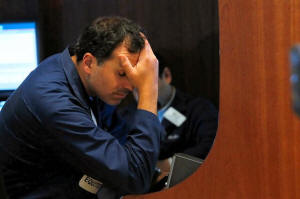|
Worst day in 10 months as
Wall Street reacts to 'Brexit'
 Send a link to a friend
Send a link to a friend
 [June 25, 2016]
By Rodrigo Campos [June 25, 2016]
By Rodrigo Campos
NEW YORK (Reuters) - The S&P 500 turned
negative for the year-to-date on Friday as Wall Street suffered its
largest selloff in 10 months after Britain's decision to leave the
European Union caught traders wrong-footed.
In the busiest trading volume for a single session in nearly five
years, financial stocks <.SPSY> led the decline on the S&P 500 with
a 5.4 percent drop -the largest for the sector since November 2011.
The S&P 500 lost all the year's gains and suffered its largest
decline since late August last year.
Equity futures neared an 11-month high to start the overnight
session as markets wrongly bet that the "Remain" camp would prevail
in Britain's referendum, but sold off sharply as the results showed
otherwise - even triggering a market stop put in place to curtail
volatility.
The decline during regular market hours seemed more orderly, and the
S&P managed to close in the area of what analysts called significant
technical support, near 2,040.
Still, many expect the next weeks to remain volatile.
The CBOE Volatility index <.VIX> ended up 49 percent at 25.76, its
highest level since Feb. 11 - when equities hit their lows of the
year.

"The market has really not fully digested the second-order impacts
of this," said Stephen Auth, chief investment officer at Federated
Investors in New York.
"We are keeping our clients in dividend stocks and on a defensive
strategy," he said. "That's the story until we reach better
risk-reward levels," which Auth said could be near the S&P 500's
February low near 1,830.
High-dividend-paying utilities <.SPLRCU> were the only S&P 500
sector to end the day in the black, with a meager 0.09 percent gain.
The Dow Jones industrial average <.DJI> fell 611.21 points, or 3.39
percent, to 17,399.86, the S&P 500 <.SPX> lost 76.02 points, or 3.6
percent, to 2,037.3, and the Nasdaq Composite <.IXIC> dropped 202.06
points, or 4.12 percent, to 4,707.98.
Many market participants, however, saw the broad-based decline as an
opportunity for investors on the sidelines to gradually increase
their stock holdings.
"What I see going to happen is the Federal Reserve will not raise
rates in 2016, that is off the table and a market positive," said
Doug Cote, chief market strategist at Voya Investment Management in
New York.
"If you have cash on the sidelines it could be a buying opportunity
but I wouldn't be changing (bonds-stocks) allocations right now," he
said, adding he expects other major central bank's policies to also
give the market support.
[to top of second column] |

A trader works on the floor of the New York Stock Exchange (NYSE) in
New York, U.S., June 24, 2016. REUTERS/Lucas Jackson

The weekly declines in the S&P 500 and Dow industrials, both off 1.6
percent, were the largest since February, and the Nasdaq's 1.9
percent drop was marginally lower than the previous week's.
The relatively less severe weekly decline points to an unraveling of
trades put in place after polls last weekend showed increasing
momentum for the "Remain" camp in the British referendum.
Traders were closely following moves in currencies, calling them the
contagion mechanism between markets. The pound <GBP=> tumbled to
near $1.32, its lowest level since 1985, before bouncing back to a
loss of 8 percent at $1.3678.
The decline came on fears the Britons' decision to leave the EU
could hurt investment and usher in many months of both political and
economic uncertainty.
"Expect weaker investment and thereby slower economic growth to
persist during the 2-3 year negotiations to leave the European
Union," Deutsche Bank economists said in a Friday note.
Volume in U.S. exchanges hit 15.3 billion as the trade-heavy
reconstitution of the Russell indexes crossed at the market close.
It was the highest volume since August 2011 according to Bats Global
Markets and compares with the daily average of 6.8 billion over the
last 20 trading sessions.
Declining issues outnumbered advancing ones on the NYSE by a
5.47-to-1 ratio, and on the Nasdaq, a 5.20-to-1 ratio favored
decliners.

The S&P 500 posted 28 new 52-week highs and 12 new lows; the Nasdaq
recorded 33 new highs and 107 new lows.
(Reporting by Rodrigo Campos; Editing by Leslie Adler and Sandra
Maler)
[© 2016 Thomson Reuters. All rights
reserved.] Copyright 2016 Reuters. All rights reserved. This material may not be published,
broadcast, rewritten or redistributed. |